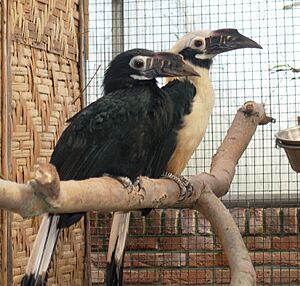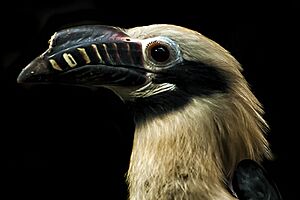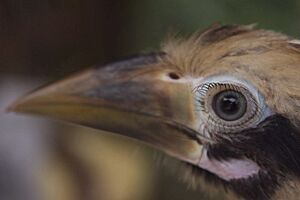Visayan hornbill facts for kids
Quick facts for kids Visayan hornbill |
|
|---|---|
 |
|
| A pair of Visayan hornbills at Avifauna in Alphen aan den Rijn, Netherlands. | |
| Conservation status | |
| Scientific classification | |
| Genus: |
Penelopides
|
| Species: |
panini
|
The Visayan hornbill (Penelopides panini) is a special type of hornbill bird. It lives in the rainforests of the Western Visayas region in the Philippines. You can find it on islands like Panay, Negros, Cebu, Guimaras, and Masbate. Sadly, it used to live on Ticao too, but it's probably gone from there now. This bird was once thought to be the same as other Philippine tarictic hornbills, but now we know it's its own unique species.
Contents
About the Visayan Hornbill
The Visayan hornbill was first described by a French scientist named Georges-Louis Leclerc, Comte de Buffon in 1780. Later, in 1783, a Dutch scientist named Pieter Boddaert gave it its scientific name, Buceros panini. The name panini comes from the island of Panay, where this bird was first found. The Visayan hornbill is now part of a group of birds called Penelopides. The name Penelopides might mean "almost a crest" or "resembling a crest," which refers to a feature on the bird's head. The common English name "Visayan hornbill" tells us it lives in the Visayan Islands in the central Philippines.
There are two main types, or subspecies, of the Visayan hornbill:
- P. p. panini – This is the most common type. It lives on Panay, Negros, Masbate, and Guimaras.
- P. p. ticaensis – This type lived on Ticao Island. Sadly, it is now likely extinct.
What Does It Look Like?
Adult Visayan hornbills look different depending on whether they are male or female. This is called sexual dimorphism.
The male bird has a creamy-white head and neck. Its upper chest is white, and its lower chest and tail feathers are reddish-brown. The tip of its tail is black. Its beak and the casque (a helmet-like growth on top of the beak) are blackish, with yellowish lines. The skin around its eyes is pinkish-white.
The female bird has a tail and beak similar to the male's. However, the rest of her feathers are black. The skin around her eyes is blue.
Diet and Behavior
Visayan hornbills usually live in groups. They spend most of their time high up in the trees of the rainforest. These birds are quite noisy! They make a constant sound that sounds like ta-rik-tik. This is why they are sometimes called "tarictic hornbills." Even though they are noisy, they can be hard to spot because their colors help them blend in with the thick leaves of the forest.
Their main food is fruit. They also eat insects, like beetles and ants. Sometimes, they might even eat earthworms, but this is rare.
Protecting the Visayan Hornbill
The Visayan hornbill is a highly endangered species. This means it is at a very high risk of disappearing forever. Scientists believe there are only about 1,800 of these birds left in the wild.
Their numbers have dropped a lot because of two main reasons:
- Hunting: People sometimes hunt these birds.
- Habitat Loss: Their forest homes are being destroyed by deforestation. This happens when trees are cut down for farms, buildings, or wood.
The type of Visayan hornbill from Ticao Island (ticaensis) was common in 1905. But during the 20th century, almost all the forests on Ticao Island were replaced by farms and towns. The last time anyone saw a Ticao tarictic hornbill was in 1971. It is now very likely extinct. If this is true, it would be the first type of hornbill to go extinct in recent history. Many other hornbill species are also in danger.
Visayan Hornbills in Zoos
Some Visayan hornbills have been brought from Panay in the Philippines to zoos. For example, Chester Zoo in England has two pairs of these birds. Avifauna in the Netherlands also has two pairs, among other places.
In the past, the Los Angeles Zoo successfully bred this species. However, it's not certain if those birds were pure Visayan hornbills. So, the first confirmed breeding of this species might have happened at a breeding center on Panay Island, where the Chester Zoo birds came from. Chester Zoo has also successfully bred this species.




